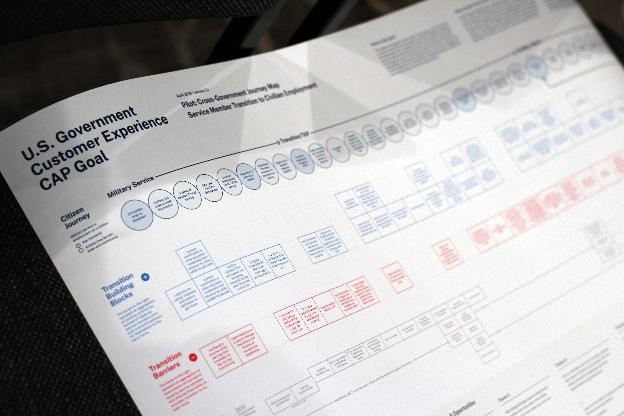Form 2900-0876-R2 Cross Agency Field Guide
Clearance for A-11 Section 280 Improving Customer Experience Information Collection
Cross Agency Field Guide_August 2020
MAPPING THE CROSS-AGENCY CUSTOMER EXPERIENCE JOURNEY
OMB: 2900-0876
EXAMPLE
CUSTOMER
INTERVIEW
GUIDE
–
PROPRIETARY
AND
CONFIDENTIAL 


CUSTOMER EXPERIENCE CROSS AGENCY PRIORITY GOAL: 2020 cross-agency journey mapping project
Research Field Guide
AUGUST 2020
Key Interviewees & Observations

 Who
can we ask?
Who
can we ask?
 Customers:
Individuals that have navigated these services across:
Customers:
Individuals that have navigated these services across:




Counties Tribes Socioeconomic Drivers Demographics
 Care
Management
Organizations:
Organizations that
provide medical,
health, social and disaster recovery services to
the public
Care
Management
Organizations:
Organizations that
provide medical,
health, social and disaster recovery services to
the public
 Case
Management Workers:
Employees who
provide services
for people who are
applying for or are enrolled in benefit
programs
Case
Management Workers:
Employees who
provide services
for people who are
applying for or are enrolled in benefit
programs
 Local
and State-Based Partners: Employees of local and state government
programs that are often Federally funded and provide more direct
interactions with customers navigating these services
Local
and State-Based Partners: Employees of local and state government
programs that are often Federally funded and provide more direct
interactions with customers navigating these services
 What
can we observe?
What
can we observe?
 Enrollment
Processes: Process steps, interactions between workers and
members, emotions and thoughts while going through the process
Enrollment
Processes: Process steps, interactions between workers and
members, emotions and thoughts while going through the process
 Enrollment
Location:
Wait rooms,
resources, signage,
surroundings, types
of people coming
in-person
Enrollment
Location:
Wait rooms,
resources, signage,
surroundings, types
of people coming
in-person
 Geographic
and
Socioeconomic
Features:
Grocery stores,
playgrounds, signage,
public schools,
health care
services, neighborhood
safety, housing
stability, income
level, access to resources
Geographic
and
Socioeconomic
Features:
Grocery stores,
playgrounds, signage,
public schools,
health care
services, neighborhood
safety, housing
stability, income
level, access to resources
Interview Best Practices
 The
team
will
be
objective
and
create
a
comfortable
atmosphere for
Interviewees.
The
team
will
be
objective
and
create
a
comfortable
atmosphere for
Interviewees.
BEST PRACTICES
Come prepared. Bring professional IDs (Deloitte) and government-issued IDs (others) to prove your identity. It never hurts to have some business cards on hand to provide Interviewees.
Dress for success. Dress in a manner that puts the Interviewees at ease, while maintaining professionalism. The HCD team typically dresses in business casual attire.
Find your buddy. Field research should not be conducted alone; it’s a buddy system. At a minimum, interviews require two HCD team members. Researchers must simultaneously observe the same subjects/Interviewees.
Establish your roles. Be clear with your research partner on roles – one person should be the designated facilitator and one should be fully devoted to capturing notes. Additional folks in the room can be responsible for capturing photos, voice recordings, and/or videos.
Set the tone. Spend a few minutes on small talk at the beginning to set the mood. The conversation should feel informal, open, and non-judgmental. Be aware of your body language. What tone are you setting?
Let Interviewees know upfront that responses are anonymous.
Explain that they have the right to opt-out at any part of the interview.
Assure Interviewees there’s no right or wrong answer.
Ask permission to audio record Interviewees, and if not, write as close to verbatim as possible.
Think about framing. Questions should be stated in an agnostic manner that shows no bias. Conduct interviews as conversations, not inquiries.
Maintain Interviewee integrity. Notes on observations should be objective, devoid of speculation.
Set yourself up for success later. Use the following tips to organize your notes:
Time stamp notes to the extent possible to easily navigate later.
Put a symbol next to key insights or quotes in field notes – capturing quotes can be a powerful tool during synthesis! Be sure you’re capturing language (verbatim where possible) and tone.
Notes between researchers will not be shared until after debrief to avoid bias and group-think.
Track notes and demographic sheets to individual Interviewees using a number or symbol
Make room for silence. Don’t interrupt Interviewees and try to wait at least three seconds after they pause before speaking in response.
Close out the conversation. Thank the Interviewee for his/her time and let them know any next steps. Be sure to collect their contact information if they’re comfortable so they can be kept in the loop.
Reflect and debrief while fresh. Always debrief individually (5-10 minutes), then debrief key insights as a group before moving onto the next conversation / observation.
USEFUL
PHRASES
DURING
THE INTERVIEW


In the Field
INTERVIEW
FLOW
-
FACILITATOR
NOTE-TAKER
OBSERVER
Brief introductions
Small talk
Overview of interview purpose
Interview
Thank them for their time
Record audio
Use a pen and paper to record all notes
Record exactly what the Interviewee is saying
Do not interrupt the facilitator, but join when invited at the end with follow- up questions
ALL ROLES
Use a pen and paper to record key quotes in the conversation
Note any visible actions related to body language or attitude
Listen attentively and only join when invited at the end with follow-up questions
Debrief interviews (individual)
Debrief interviews (team)
Debrief and insights at the end of each day and site visit
Develop Weekly Field Research Insights Brief for circulation to team leadership
The Interviewee is the expert
Avoid leading questions
Look for stories
Use the Interviewee’s own words
Use silence strategically (wait 3 – 5 seconds after they’ve stopped talking)
Make notes on things you want to follow-up on
Use short-hand when possible (e.g., >,<,=, , *)
Do not synthesize on the fly
Document the unstated, including body language and voice changes
Keep track of questions that you gather
Mark points in the conversation that seem important
Time-Stamp notes with the time on the audio recording
Keep track of timestamps for key quotes
Document responses to support the Note-Taker for lengthy or important responses
Keep track of questions you gather for follow-up or key ideas for synthesis
“Walk me through your…”
“Tell me more about…”
“Tell me about a time when…”
“Tell me about the last time you…”
“Earlier, you said…”
“Why?”
“Please explain…”
(When invited by Facilitator)
“Thank you for sharing…”
“Earlier, you mentioned [X], can you tell me more about that?
(When invited by Facilitator)
Thank you for sharing…”
“Earlier, you mentioned [X], can you tell me more about that?
AFTER
THE INTERVIEW
Debrief
alone
(5-10
mins)
at
first,
cleaning
notes,
and
highlighting
key
stories,
soundbites,
and
initial
insights Debrief
internally (20-25 min) and note any interesting stories, quotes,
and
observations Summarize
key
takeaways Identify
what’s working, what’s not – adjust your process
accordingly Discuss
internally additional focus areas for future
interviews
Interview Roles and Responsibilities
A general rule of thumb is to have two to three researchers in each one-on-one interview.
OVERVIEW
Aligning on role assignments and responsibilities before interviews is key to facilitating a seamless, Interviewee-centered ethnographic conversation.
PREFERRED OPTION




*This team structure is used when possible and a Representative is available to assist the research team in rapport building as well as observing the interview.
Interview Structure
Interviews will be 45-60 minutes to capture rich stories about the assignment experience.

Get
Interviewee
Comfortable
(Facilitator)
– Exchange
names, shake
hands, thank
them for
participating, spend
a few
minutes asking
about how
long they’ve
lived in
the area.
Explain
Why We
are Here
(Facilitator)
– Share
that we
are conducting
a study
on behalf
of a Federal team to better understand the customer
experience navigating either disability or disaster recovery
services and benefits. Introduce yourself as the
Facilitator.
INTRODUCE THE TEAM (5 MIN)
Establish Credibility
(Facilitator)
– Explain that this effort is in support of a project with
the program. Introduction will be adjusted as necessary.
Explain Roles
(Facilitator)
– Share that we will spend the majority of the next hour
hearing from you, and I will ask some follow up questions along the
way. Introduce the Note-
Taker &
Observer: My
colleague(s) will be focused on taking notes and recording, if
applicable, during the session. We hope to spend 60 minutes with
you.
Describe
Interview:
We want
to hear
your candid,
honest experiences.
There are
no right
or wrong answers. This is unlike a typical interview. There
is no set list of questions, so we’ll be asking
open-ended questions
and going
wherever the
interview leads.
DOCUMENTATION DISCLAIMER (3 MIN)
Describe Documentation of the Interview (Facilitator) – Share that this conversation is voluntary and anonymous. This study involves notetaking, potentially taking a photo at the end, and using some of the quotes (anonymously) in our final report. Interviewees are assigned a code and quotes are not attributed. Please let us know if you have any questions.

Shepherd
the
Stories
(Facilitator)
– Dive
into the
conversation, using
the questions
listed on the
following pages to guide
facilitation.
THANK INTERVIEWEE AND CLOSE OUT (2 MIN)
Thank Interviewee – Thank you for participating. Is it ok if we contact you with any follow-up questions or clarifications? Provide your contact information and offer to take any follow up questions or insights. Share that the project will be published on performance.gov/cx

SAMPLE QUESTIONS / SCRIPT
Thank you for your consideration to connect with our team. We are supporting a cross-government Federal effort to better understand the journey of people like you, and how we might improve the way in which we design and deliver services. To learn more about this effort, please visit: https://performance.gov/2020cxmaps.
Overview
Our goal for this session is to capture your unique story and experiences. Together with others, we will identify common barriers, bright spots, and meaningful moments we can improve or build upon. We would like to spend up to 60 minutes with you and gather insights that will remain anonymous and synthesized in order to help support an enhanced customer experience.
If you are interested in being interviewed by our team, please sign-up for a time that works for you here: [insert link]
What to know
Taking part is voluntary: Participation in this conversation is completely voluntary. You may inform us that you wish to end your participation in the conversation at any time. You can take a break, choose not to answer any question(s), stop and continue at a later time, or stop altogether. If you decide to withdraw from this conversation, we will ask you if the information already collected can be used. If you tell us no, we will not use that information.
Confidentiality and Privacy: We minimize the personal information that we collect and will not identify you as a source of information (i.e., we will not use any personally identifiable information such as last name, social security number, etc.). In addition, disclosure of any private details to us is at your discretion and you are not obligated to provide any information you are not comfortable sharing. We respect your privacy. In the United States, the Paperwork Reduction Act requires the Federal government to outline how information collections like these will be conducted, and how that information will be used. You can find more about our “PRA statement” at the website listed above, and the control number this collection has been approved under is 2900-0876.
How we’ll use the information: We will create a customer journey map that aggregates insights we learn across customer stories. An example of what this looks like can be found here: https://www.performance.gov/mapping-cx-journey/ We also plan to create customer cards (example of which can also be found at the above website), that share summaries of individual stories, but will not attribute it in a way that is identifying. If you are comfortable, at some point we may ask if you are ok with us taking pictures and using these pictures in the project summary materials.
Types of questions we’ll ask: The questions below are a notional example of the types of questions our team might pose during an interview. These questions are subject to change based on individual situations and contexts.
Kicking it Off
● Tell us a bit about yourself and your family
● What type of work or hobbies do you enjoy?
● Tell us a bit about your neighborhood/community
Interacting with Services
● How did you learn about [disability/disaster assistance and services] (e.g. through friends/family, school, community providers, hospitals, etc.)?
● In the past month/year/appropriate timeframe, what services or benefits have you received?
● How do the services and benefits you receive help you?
● What people or places have been most important / helpful to you?
High Points and Low Points
● Can you describe any memorable moments or experiences related to receiving these services?
● Tell us about a time when you felt stress or worry related to your care or services
● Describe a time that you felt supported by your case worker, or someone else assisting you?
● What are some barriers or challenges you’ve faced related to these services / benefits?
Family and Community
● How do you family or friends assist you with getting the care or services you need?
● Where do you go in your community or neighborhood to receive care or services?
Reflection
● When you think about the care and services you receive, how do you usually feel?
● If you could change anything about how you receive care or services, what would you change?
● If you could give advice to someone else seeking care or services, what advice would you give?
EXAMPLE
CUSTOMER
INTERVIEW
GUIDE
–
PROPRIETARY
AND
CONFIDENTIAL 
| File Type | application/vnd.openxmlformats-officedocument.wordprocessingml.document |
| File Title | PowerPoint Presentation |
| Author | Angela Mikolajewski Welle (US - Arlington) |
| File Modified | 0000-00-00 |
| File Created | 2021-01-13 |
© 2026 OMB.report | Privacy Policy